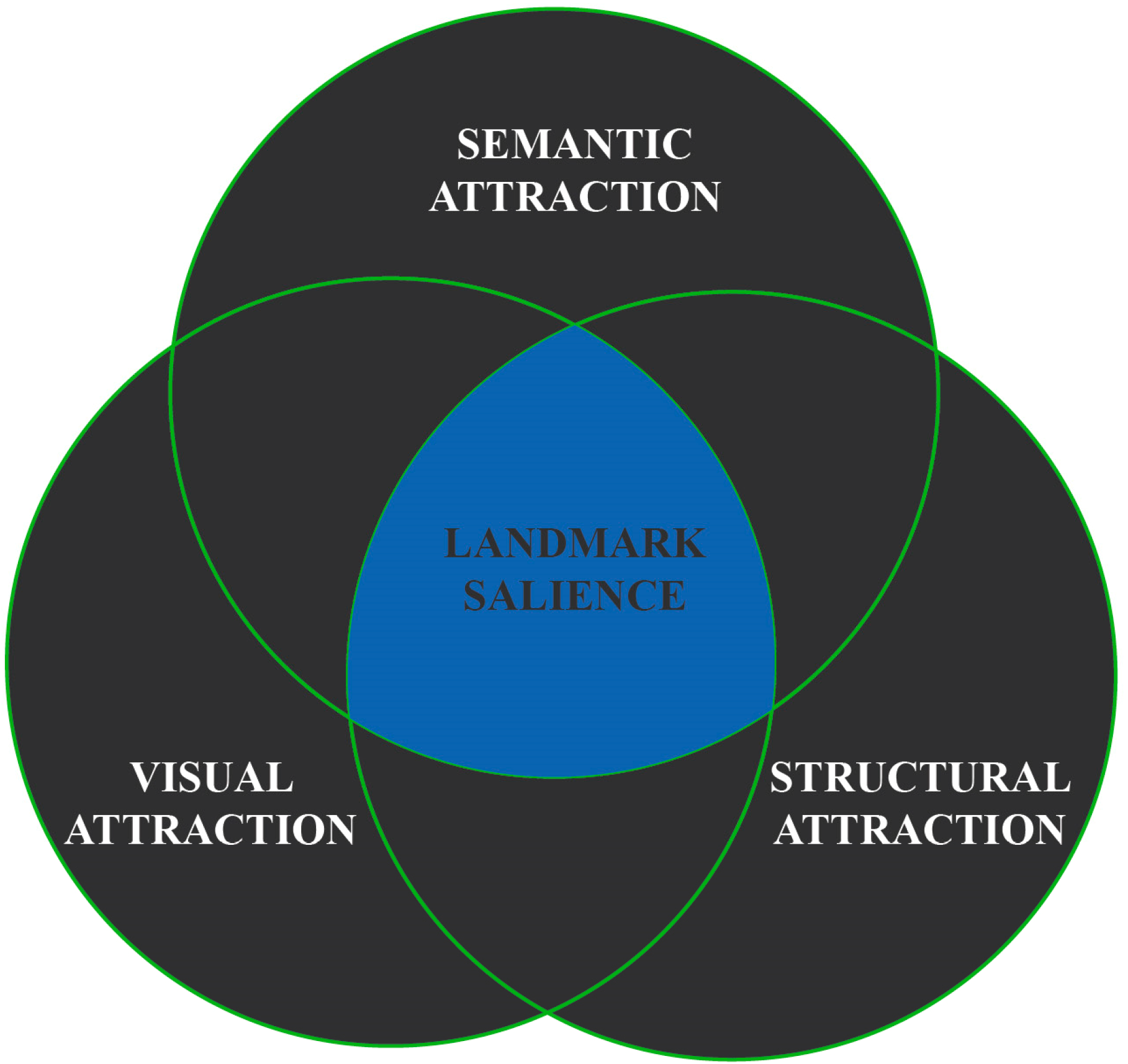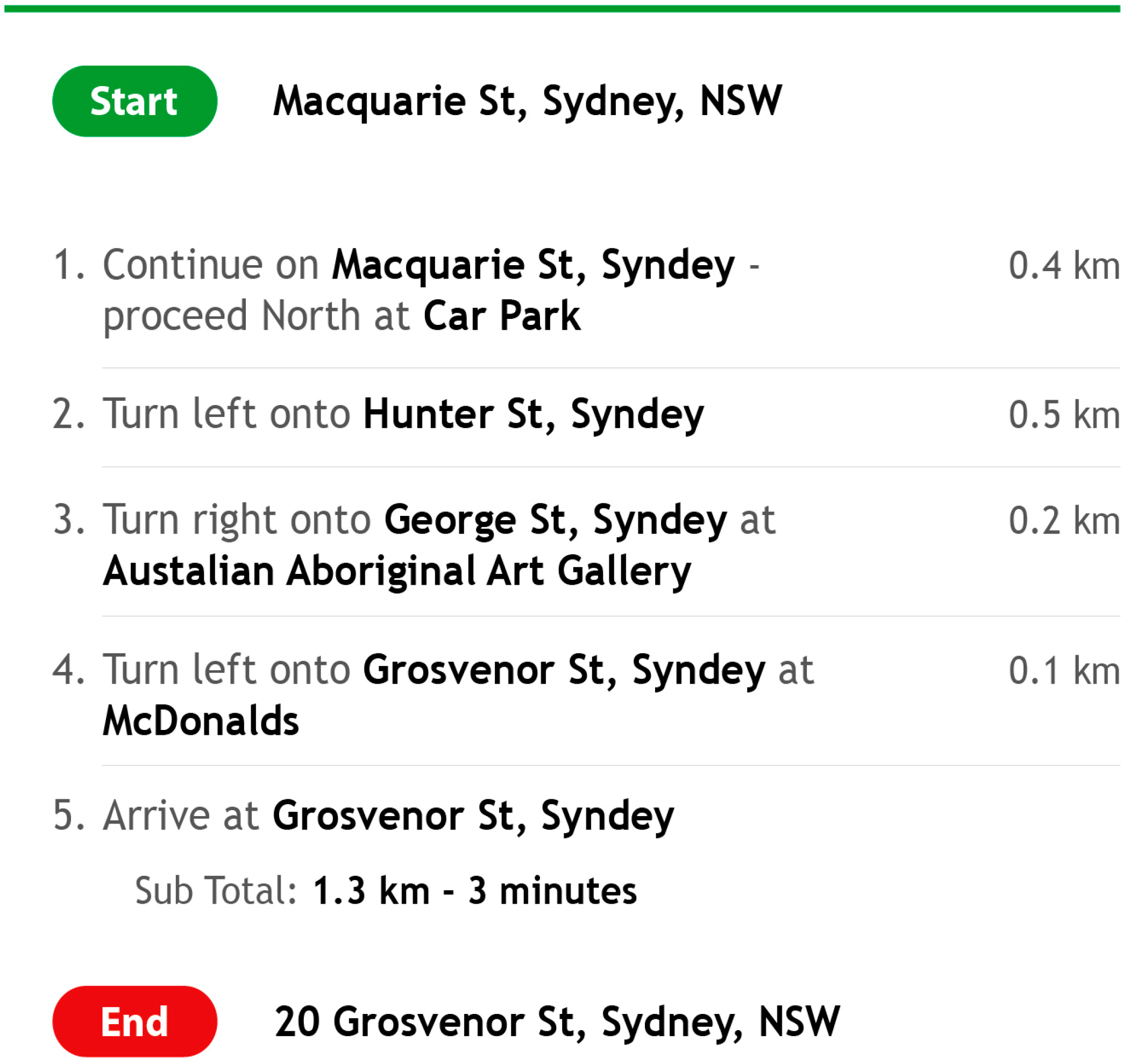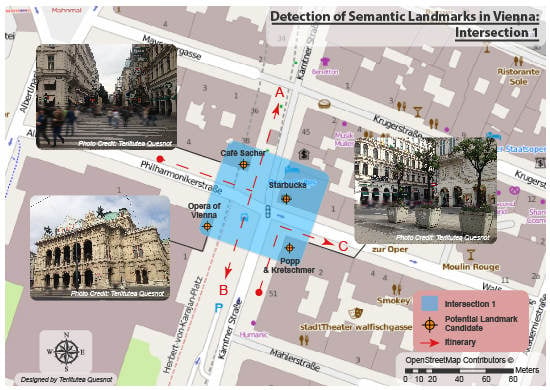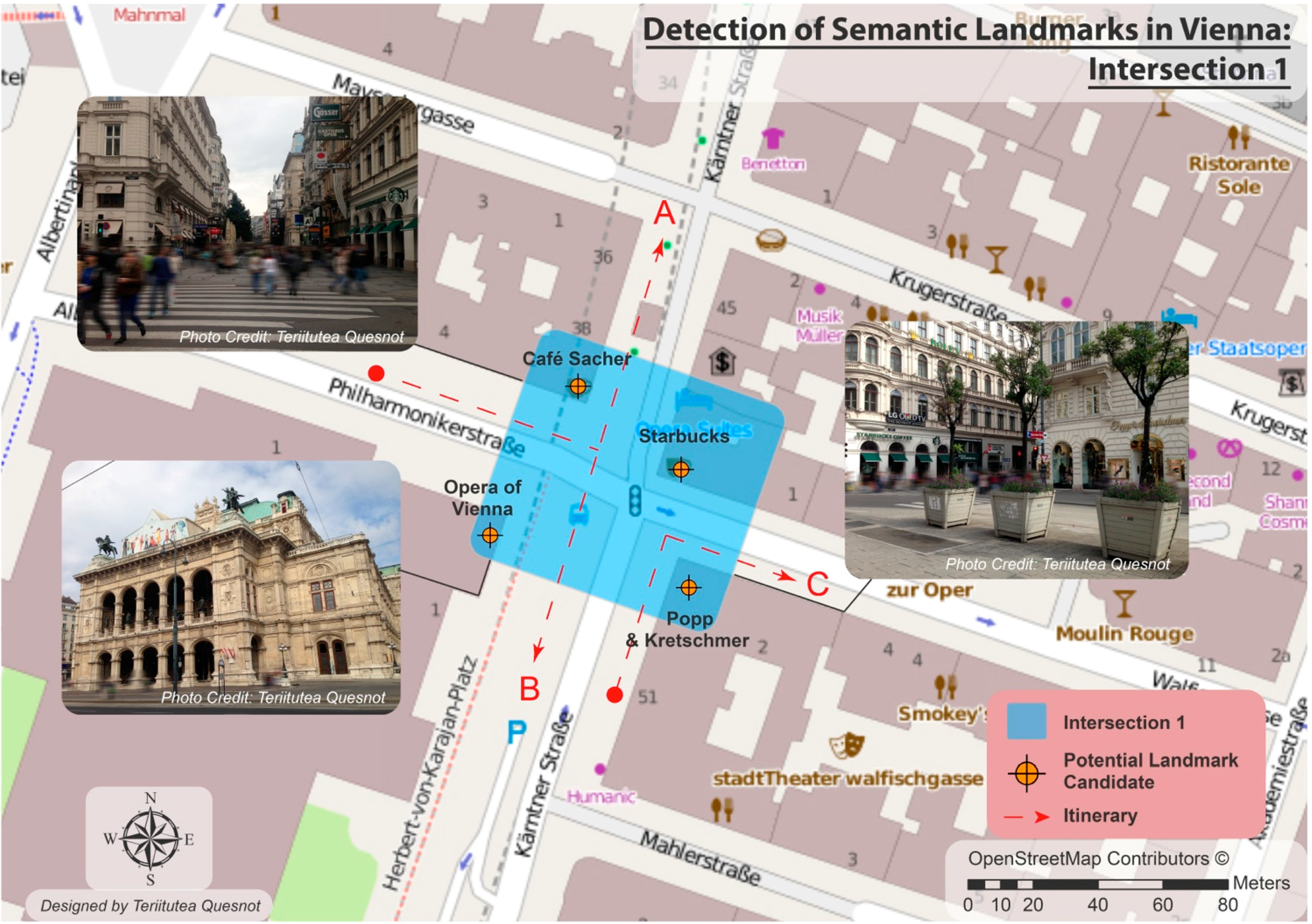Measure of Landmark Semantic Salience through Geosocial Data Streams
Abstract
:1. Introduction
2. Human Wayfinding
2.1. Definition of Human Wayfinding
- Orientation (i.e., being aware of our relative position compared to the final destination);
- Route selection (i.e., establishing a route in order to reach the final destination);
- Route control (i.e., following the route previously established);
- Recognition of destination (i.e., realizing that we have reached the final destination).
2.2. Human Spatial Knowledge

2.3. Assisted Wayfinding
3. Toward the Automatic Detection of Landmarks
3.1. Landmarks Salience and Automatic Landmarks Detection Systems
3.1.1. Formal Model of Landmarkness

3.1.2. Automatic Landmark Detection Systems
| References | Semantic Salience | Description |
|---|---|---|
| Raubal and Winter [39] | √ | Historical and cultural significance of the building’s facade; Explicit mark on the building’s facade. |
| Elias [45] | √ | Function of the building. |
| Winter [41] | Ø | Focus on buildings’ visual salience (advance visibility). |
| Tomko [47] | √ | Semantic Web. |
| Tekuza and Tanaka [48] | √ | Semantic Web. |
| Klippel and Winter [43] | Ø | Focus on the buildings’ structural salience. |
| Winter et al. [42] | Ø | Focus on the context of navigation (mode of travelling, environment, etc.). |
| Caduff and Timpf [49] | Ø | Focus on the buildings’ visual salience (distance, orientation, and visibility). |
| Elias and Sester [50] | √ | Brevity (numbers of words used to refer the object). |
| Richter and Klippel [51] | Ø | Focus on buildings’ structural salience (distance separating landmarks and decision points, relative positions of landmarks). |
| Winter et al. [46] | Ø | Focus on buildings’ visual salience (height of buildings). |
| Duckham et al. [52] | √ | Ubiquity and familiarity of buildings; Length of description. |
| Schroder et al. [25] | √ | Historical and cultural significance; Function. |

3.2. Challenges and Issues Related to ALDSs
- First of all, ALDSs mostly focus on visual and structural attributes of buildings while their semantic meaning is also crucial (cf. Table 1). Moreover, traditional approaches are exclusively based on static and objective attributes (e.g., heights of buildings). Dynamic and subjective attributes, such as number of visitors, should also be taken in consideration. We did not identify any solution that takes into account such dynamic attributes.
- Since the evaluation of actual weighting is difficult to evaluate, traditional approaches apply a uniform weighting to each objects’ attributes. That being said, Winter et al. [42] give a trail to follow with their work on the context of navigation. Furthermore, Duckham et al. [52] apply adjustable weighting since their measure of landmarkness is route dependent.
- Apart from few solutions (e.g., [53]), only buildings are taken into account. Other types of objects, like trees, are ignored. Yet, buildings are far from being the only item that can serve as landmarks for navigation [37]. Even if Duckham et al. acknowledge that objects other than buildings should be taken into account, their solution does not derogate from this rule [52].
- Traditional solutions focus only on landmarks located at choice points or potential choice points. However, on-route and off-route points are also crucial in navigation [30]. We must state that the extended Core LNM includes the selection of landmarks off decision points.
3.3. The Potential of Crowdsourcing for the Automatic Detection of Landmarks
4. Social Location Sharing Datasets as a Reliable Source of Information for the Measure of Landmark Semantic Salience
4.1. Why Use Social Location Sharing Data to Measure Landmark Semantic Salience?
4.1.1. A Relevant Indicator of Places’ Collective and Individual Meaning
4.1.2. Social Location Sharing Data Are Representative of Cities’ Everydayness
4.1.3. User-Generated Place Databases are Appropriate for the Measure of Landmark Semantic Salience
- First of all, online social networks’ users operate a kind of “semantic filter” by adding (or not) places. Indeed, the presence of a venue inside a UGPD obviously indicates users’ interests. In other words, the presence versus the absence of a given place constitutes a global semantic indicator that can be combined with additional local indicators, such as the number of check-ins, comments or tips published from that place.
- Secondly, unlike locational data, check-ins are always associated with a place for which geographical coordinates are stored in a database. This principle guarantees a positional uniformity. For example, with the exception of geo-tagged tweets sent from Foursquare, two tweets published from the same place may have different geographic coordinates depending on the precision of the mobile device from which they were posted.
- Thirdly, SLS data allow us to categorize each place according to check-ins’ activities during daytime and nighttime (especially for Swarm check-ins). Thus, these data can also be used to improve the detection of semantic landmarks for the nighttime period.
- Finally, online social networks present the advantage of providing a wide range of place categories. Unlike traditional approaches centered on the selection of buildings as landmark candidates, a platform, such as Foursquare, gives access to several types of objects, including natural items (e.g., garden or even mountains), that can also serve as landmarks. However, we must acknowledge that a large part of UGPDs are essentially composed of buildings.
4.1.4. Daily Footprints Left by Social Media Users can be Used to Improve the Navigation Context-Based Landmark Detection
4.2. How Landmark Semantic Salience can be Measured through SLS Data Streams?
4.2.1. Uniqueness of Venues
4.2.2. Geosocial Activity of Venues
4.2.3. Landmark Semantic Salience
6. Conclusions
Acknowledgments
Author Contributions
Conflicts of Interest
References
- Calabrese, F.; Colonna, M.; Lovisolo, P.; Parata, D.; Ratti, C. Real-time urban monitoring using cell phones: A case study in Rome. IEEE Trans. Intell. Transp. Syst. 2011, 12, 141–151. [Google Scholar] [CrossRef]
- Calabrese, F.; Kloeckl, K.; Ratti, C. Wikicity: Real-time location-sensitive tools for the city. Handb. Res. Urban Infor. 2008, 390–413. [Google Scholar]
- Calabrese, F.; Pereira, F.C.; Di Lorenzo, G.; Liu, L.; Ratti, C. The geography of taste: Analyzing cell-phone mobility and social events. Pervasive Comput. 2010. [Google Scholar] [CrossRef] [Green Version]
- Ratti, C.; Sevtsuk, A.; Huang, S.; Pailer, R. Mobile landscapes: Graz in real time. In Location Based Services and Telecartography; Springer: New York, NY, USA, 2007; pp. 433–444. [Google Scholar]
- Ratti, C.; Williams, S.; Frenchman, D.; Pulselli, R. Mobile landscapes: Using location data from cell phones for urban analysis. Environ. Plan. B 2006, 33, 727–748. [Google Scholar] [CrossRef]
- Reades, J.; Calabrese, F.; Sevtsuk, A.; Ratti, C. Cellular census: Explorations in urban data collection. IEEE Pervasive Comput. 2007, 6, 30–38. [Google Scholar] [CrossRef]
- Goodchild, M.F. Citizens as sensors: The world of volunteered geography. Geo J. 2007, 69, 211–221. [Google Scholar]
- Exner, J.; Hemsley, J. Urban monitoring laboratory: New benefits and potential for urban planning through the use of urban sensing, geo- and mobile-web. In Real CORP Proceedings; Competence Center of Urban and Regional Planning: Essen, Germany, 2011; pp. 1087–1096. [Google Scholar]
- Crampton, J.; Graham, M.; Poorthuis, A.; Shelton, T.; Stephens, M.; Wilson, M.W.; Zook, A.M. Beyond the geotag: situating ‘big data’ and leveraging the potential of the geoweb. Cartogr. Geogr. Inf. Sci. 2013, 40, 130–139. [Google Scholar]
- Tang, K.P.; Lin, J.; Hong, J.I.; Siewiorek, D.P.; Sadeh, N. Rethinking location sharing: Exploring the implications of social-driven vs. purpose-driven location sharing. In Proceedings of UbiComp 2010, Copenhagen, Denmark, 26–29 September 2010.
- Thatcher, J. Living on fumes: Digital footprints, data fumes, and the limitations of spatial big data. Int. J. Commun. 2014, 8, 1765–1783. [Google Scholar]
- Giffinger, R.; Fertner, C.; Kramar, H.; Kalasek, R.; Pichler-Milanovic, N.; Meijers, E. Smart Cities: Ranking of European Medium-Sized Cities, Centre of Regional Science (SRF); Vienna University of Technology: Vienna, Austria, 2007. [Google Scholar]
- Chourabi, H.; Nam, T.; Walker, S.; Gil-Garcia, J.R.; Mellouli, S.; Nahon, K.; Pardo, T.; Scholl, H.J. Understanding smart cities: An integrative framework. In Proceedings the of 45th Hawaii International Conference on System Sciences, Maui, HI, USA, 4–7 January 2012.
- Batty, M. The New Science of Cities; The MIT Press: Cambridge, MA, USA, 2013. [Google Scholar]
- Roche, S. Geographic Information Science I: Why does a smart city need to be spatially enabled? Progr. Hum. Geogr. 2013. [Google Scholar] [CrossRef]
- Farr, A.C.; Kleinschmidt, T.; Yarlagadda, P.; Mengersen, K. Wayfinding: A simple concept, a complex process. Transport. Rev. 2012, 32, 715–743. [Google Scholar] [CrossRef] [Green Version]
- Lynch, K. The Image of the City; MIT Press: Cambridge, UK, 1960. [Google Scholar]
- Downs, R.M.; Stea, D. Cognitive maps and spatial behavior: Process and product. In Image and Environment; Stea, D., Downs, R.M., Eds.; Aldine Publishing: Chigao, IL, USA, 1973; pp. 8–26. [Google Scholar]
- Golledge, R.G. Human wayfinding and cognitive maps. In Wayfinding Behavior: Cognitive Mapping and Other Spatial Processes; Golledge, R.G., Ed.; Johns Hopkins University Press: Baltimore, MD, USA, 1999; pp. 5–45. [Google Scholar]
- Montello, D.R.; Raubal, M. Functions and applications of spatial cognition. In The APA Handbook of Spatial Cognition; Waller, D., Nadel, L., Eds.; American Psychological Association: Washington, DC, USA, 2013; pp. 555–591. [Google Scholar]
- Davies, C.; Li, C.; Albrecht, J. Human understanding of space. In Interacting with Geospatial Technologies; Haklay, M.M., Ed.; John Wiley & Sons Ltd.: Chichester, UK, 2010; pp. 19–35. [Google Scholar]
- Kitchin, R.; Blades, M. The Cognition of Geographic Space; Tauris: London, UK, 2002. [Google Scholar]
- Siegel, A.W.; White, S.H. The development of spatial representations of large scale environments. In Advances in Child Development and Behavior; Reese, W.H., Ed.; Academic Press: New York, NY, USA, 1975. [Google Scholar]
- Ishikawa, T.; Nakamura, U. Landmark selection in the environment: Relationships with object characteristics and sense of direction. Spat. Cogn. Comput. 2012, 12, 1–22. [Google Scholar]
- Schroder, C.J.; Mackaness, W.A.; Gittings, B.M. Giving the “right” route directions: The requirements for pedestrian navigation systems. Trans. GIS 2011, 15, 419–438. [Google Scholar] [CrossRef]
- Montello, D.R. A new framework for understanding the acquisition of spatial knowledge in large-scale environments. In Spatial and Temporal Reasoning in Geographic Information Systems; Egenhofer, M.J., Golledge, R.G., Eds.; Oxford University Press: New York, NY, USA, 1998; pp. 143–154. [Google Scholar]
- Denis, M.; Fernandez, G. The processing of landmarks in route directions. In Representing Space in Cognition: Interrelations of Behaviour, Language, and Formal Models; Tenbrink, T., Wiener, J., Claramunt, C., Eds.; Oxford University Press: Oxford, UK, 2013; pp. 42–55. [Google Scholar]
- Denis, M.; Michon, P.E.; Tom, A. Assisting pedestrian wayfinding in urban settings: Why references to landmarks are crucial in direction-giving. In Applied Spatial Cognition: From Research to Cognitive Technology; Allen, G.L., Ed.; Lawrence Erlbaum: Mahwah, NJ, USA, 2007; pp. 25–51. [Google Scholar]
- Daniel, M.-P.; Denis, M. Spatial descriptions as navigational aids: A cognitive analysis of route directions. Kognitionswissenschaft 1998, 7, 45–52. [Google Scholar] [CrossRef]
- Lovelace, K.L.; Hegarty, M.; Montello, D.R. Elements of good route directions in familiar and unfamiliar environments. In Spatial Information Theory; Freksa, C., Mark, D., Eds.; Springer: Berlin, Germany, 1999; Volume 1661, pp. 65–82. [Google Scholar]
- Denis, M.; Pazzaglia, F.; Cornoldi, C.; Bertolo, L. Spatial discourse and navigation: An analysis of route directions in the city of Venice. Appl. Cogn. Psychol. 1999, 13, 145–174. [Google Scholar] [CrossRef]
- Denis, M. The description of routes: A cognitive approach to the production of spatial discourse. Cah. Psychol. Cogn. 1997, 16, 409–458. [Google Scholar]
- Michon, P.E.; Denis, M. When and why referring to visual landmarks in direction giving? In Spatial Information Theory; Goos, G., Hartmanis, J., van Leeuwen, J., Eds.; Springer: Berlin, Germany, 2001; Volume 2205, pp. 292–305. [Google Scholar]
- Tom, A.; Denis, M. Referring to landmark or street information in route directions: What difference does it make? In Spatial Information Theory; Kuhn, W., Worboys, M.F., Timpf, S., Eds.; Springer: Berlin, Germany, 2003; Volume 2825, pp. 362–374. [Google Scholar]
- Daniel, M.-P.; Tom, A.; Manghi, E.; Denis, M. Testing the value of route directions through navigational performance. Spat. Cogn. Comput. 2003, 3, 269–289. [Google Scholar]
- Daniel, M.-P.; Denis, M. The production of route directions: Investigating conditions that favour conciseness in spatial discourse. Appl. Cogn. Psychol. 2004, 18, 57–75. [Google Scholar] [CrossRef]
- Golledge, R.G.; Dougherty, V.; Bell, S. Acquiring spatial knowledge: Survey versus route based knowledge in unfamiliar environments. Ann. Assoc. Am. Geogr. 1995, 85, 134–158. [Google Scholar]
- Sorrows, M.E.; Hirtle, S.C. The nature of landmarks for real and electronic spaces. In Spatial Information Theory Cognitive and Computational Foundations of Geographic Information Science; Springer: Heidelberg, Germany, 1999; pp. 37–50. [Google Scholar]
- Raubal, M.; Winter, S. Enriching wayfinding instructions with local landmarks. In Geographic Information Science; Egenhofer, M.J., Mark, D.M., Eds.; Springer: Berlin, Germany, 2002; Volume 2478, pp. 243–259. [Google Scholar]
- Nothegger, C.; Winter, S.; Raubal, M. Selection of salient features for route directions. Spat. Cogn. Comput. 2004, 4, 113–136. [Google Scholar]
- Winter, S. Route adaptive selection of salient features. In Spatial Information Theory; Kuhn, W., Worboys, M.F., Timpf, S., Eds.; Springer: Heidelberg, Germany, 2003; Volume 2825, pp. 349–361. [Google Scholar]
- Winter, S.; Raubal, M.; Nothegger, C. Focalizing measures of salience for wayfinding. In Map-Based Mobile Services; Springer: Heidelberg, Germany, 2005; pp. 125–139. [Google Scholar]
- Klippel, A.; Winter, S. Structural salience of landmarks for route directions. In Spatial Information Theory; Cohn, A.G., Mark, D.M., Eds.; Springer: Ellicottville, NY, USA, 2005; Volume 3693, pp. 347–362. [Google Scholar]
- Sadeghian, P.; Kantardzic, M. The new generation of automatic landmark detection systems: Challenges and guidelines. Spat. Cogn. Comput. 2008, 8, 252–287. [Google Scholar]
- Elias, B. Extracting landmarks with data mining methods. In Spatial Information Theory; Kuhn, W., Worboys, M.F., Timpf, S., Eds.; Springer: Berlin, Germany, 2003; Volume 2825, pp. 398–412. [Google Scholar]
- Winter, S.; Tomko, M.; Elias, B.; Sester, M. Landmark hierarchies in context. Environ. Plan. B 2008, 35, 381–398. [Google Scholar] [CrossRef]
- Tomko, M. Case study—Assessing spatial distribution of web resources for navigation services. In Proceedings of the 4th International Workshop on Web and Wireless Geographical Information Systems W2GIS04, Koyang, Korea, 26–27 November 2004.
- Tezuka, T.; Tanaka, K. Landmark extraction: A web mining approach. In Spatial Information Theory; Springer: Heidelberg, Germany, 2005; Volume 3693, pp. 379–396. [Google Scholar]
- Caduff, D.; Timpf, S. The landmark spider: Representing landmark knowledge for wayfinding tasks. In Proceedings of AAAI Spring Symposium: Reasoning with Mental and External Diagrams: Computational Modeling and Spatial Assistance, Palo Alto, CA, USA, 23–25 March 2005; pp. 30–35.
- Elias, B.; Sester, M. Incorporating landmarks with quality measures in routing procedures. In Geographic Information Science 2006; Raubal, M., Miller, H.J., Frank, A.U., Goodchild, M.F., Eds.; Springer: Berlin, Germany, 2006; Volume 4197, pp. 65–80. [Google Scholar]
- Richter, K.F.; Klippel, A. Before or after: prepositions in spatially constrained systems. In Spatial Cognition V; Barkowsky, T., Knauff, M., Ligozat, G., Montello, D.R., Eds.; Springer: Berlin, Germany, 2007; Volume 4387, pp. 453–469. [Google Scholar]
- Duckham, M.; Winter, S.; Robinson, M. Including landmarks in routing instructions. J. Locat. Based Serv. 2010, 4, 28–52. [Google Scholar] [CrossRef]
- Klippel, A.; Hansen, S.; Richter, K.F.; Winter, S. Urban granularities—A data structure for cognitively ergonomic route directions. Geoinformatica 2009, 13, 223–247. [Google Scholar] [CrossRef]
- Hirtle, S.C. Geographical Design: Spatial Cognition and Geographical Information Science; Morgan & Claypool Publishers: San Rafael, CA, USA, 2011. [Google Scholar]
- Richter, K.F. Prospects and challenges of landmarks in navigation services. In Cognitive and Linguistic Aspects of Geographic Space; Raubal, M., Mark, D.M., Frank, A.U., Eds.; Springer: Heidelberg, Germany, 2013; pp. 83–97. [Google Scholar]
- Richter, K.F.; Winter, S. Harvesting user-generated content for semantic spatial information: The Case of landmarks in OpenStreetMap. In Proceedings of the Surveying & Spatial Sciences Biennial Conference, Wellington, New Zealand, 21–25 November 2011; pp. 75–86.
- Frank, A.U.; Raubal, M. GIS education today: From GI science to GI engineering. URISA J. 2001, 13, 5–10. [Google Scholar]
- Trant, J. Studying social tagging and folksonomy: A review and framework. J. Digit. Infor. 2009, 10, p. No.1. Available online: https://journals.tdl.org/jodi/index.php/jodi/article/view/269/278 (accessed on 24 June 2014).
- Crandall, D.; Backstrom, L.; Huttenlocher, D.; Kleinberg, J. Mapping the Worldʼs photos. In Proceedings of the 18th International Conference on World Wide Web, Madrid, Spanish, 20–24 April 2009.
- Hile, H.; Vedantham, R.; Cuellar, G.; Liu, A.; Gelfand, N.; Grzeszczuk, R.; Borriello, G. Landmark-based pedestrian navigation from collections of geotagged photos. In Proceedings of the 7th International Conference on Mobile and Ubiquitous Multimedia, Umea, Sweden, 3–5 December 2008; pp. 145–152.
- Schlieder, C.; Matyas, C. Photographing a city: An analysis of place concepts based on spatial choices. Spat. Cogn. Comput. 2009, 9, 212–228. [Google Scholar]
- Jordan, K.O.; Sheptykin, I.; Gruter, B.; Vatterrott, H. Identification of structural landmarks in a park using movement data collected in a location-based game. In Proceedings of SIGSPATIAL COMP’13, Orlando, FL, USA, 5–8 November 2013.
- Schwartz, R.; Naaman, M. Collective and individual mental maps of the city in social awareness streams. In Proceedings of GeoHCI Workshop at CHI 2013, Paris, France, 27–28 April 2013.
- Elwood, S.; Goodchild, M.F.; Sui, D.S. Prospects for VGI research and the emerging fourth paradigm. In Crowdsourcing Geographic Knowledge; Sui, D.S., Elwood, S., Goodchild, M.F., Eds.; Springer Netherlands: Dordrecht, The Netherlands, 2013; pp. 361–375. [Google Scholar]
- Lévy, J.; Lussault, M. Espace. In Dictionnaire de la Géographie et de L'espace des Sociétés; Belin: Paris, France, 2003; pp. 325–333. [Google Scholar]
- Lussault, M. Lʼhomme Spatial: la Construction Sociale de L’espace Humain; Seuil: Paris, France, 2007. [Google Scholar]
- Barkhuus, L.; Brown, B.; Bell, M.; Hall, M.; Sherwood, S.; Chalmers, M. From Awareness to Repartee: Sharing Location within Social Groups, CHI’08; ACM Publishing: Florence, Italy, 2008. [Google Scholar]
- Cramer, H.; Rost, M.; Holmquist, L.E. Performing a check-in: Emerging practices, norms and “conflicts” in location-sharing using foursquare. In Proceedings of Mobile HCI 2011, Stockholm, Sweden, 30 August–2 September 2011.
- Evans, L. Location-based services: Transformation of the experience of space. J. Locat. Based Serv. 2011, 5, 242–260. [Google Scholar] [CrossRef]
- Lindqvist, J.; Cranshaw, J.; Wiese, J.; Hong, J.I.; Zimmerman, J. Iʼm the mayor of my house: Examining why people use foursquare—A social-driven location sharing application. In Proceedings of the Conference on Human Factors in Computing Systems (CHI-11), Vancouver, BC, Canada, 7–12 May 2011.
- Rost, M.; Barkhuus, L.; Cramer, H.; Brown, B. Representation and communication: Challenges in interpreting large social media datasets. In Proceedings of CSCW ’13, San Antonio, TX, USA, 23–27 February 2013.
- Noulas, A.; Scellato, S.; Mascolo, C.; Pontil, M. An empirical study of geographic user activity patterns in Foursquare. In Proceedings of the Fifth International AAAI Conference on Weblogs and Social Media, Barcelona, Spain, 17–21 July 2011.
- Kelley, M.J. The emergent urban imaginaries of geosocial media. Geo J. 2013, 78, 181–203. [Google Scholar]
- Bawa-Cavia, A. Sensing the urban: Using location-based social network data in urban analysis. In Proceedings of the Ninth International Conference on Pervasive Computing, Workshop on Pervasive Urban Applications (PURBA), San Francisco, CA, USA, 12 June 2011.
- Cranshaw, J.; Schwartz, R.; Hong, J.I.; Sadeh, N. The Livehoods project: Utilizing social media to understand the dynamics of a city. In Proceedings of the Sixth International AAAI Conference on Weblogs an Social Media (ICWSM-12), Dublin, UK, 4–7 June 2012.
- Cranshaw, J.; Yano, T. Seeing a home away from the home: Distilling proto-neighborhoods from incidental data with latent topic modeling. In Proceedings of the NIPS Workshop on Computational Social Science and the Wisdom of Crowds, Whistler, Canada, 10 December 2010.
- Preotiuc-Pietro, D.; Cranshaw, J.; Yano, T. Exploring venue-based city-to-city similarity measures. In Proceedings of UrbComp 13, Chicago, IL, USA, 11–14 August 2013; ACM Publishing: Chicago, IL, USA, 2013. [Google Scholar]
- Zadrozny, P.; Kodali, R. Analyzing foursquare check-ins. In Big Data Analytics Using Splunk; Apress: New York, NY, USA, 2013; pp. 231–253. [Google Scholar]
- Richter, K.F.; Winter, S. Landmark: GIScience for Intelligent Services; Springer: Cham, Switzerland, 2014. [Google Scholar]
© 2014 by the authors; licensee MDPI, Basel, Switzerland. This article is an open access article distributed under the terms and conditions of the Creative Commons Attribution license (http://creativecommons.org/licenses/by/4.0/).
Share and Cite
Quesnot, T.; Roche, S. Measure of Landmark Semantic Salience through Geosocial Data Streams. ISPRS Int. J. Geo-Inf. 2015, 4, 1-31. https://doi.org/10.3390/ijgi4010001
Quesnot T, Roche S. Measure of Landmark Semantic Salience through Geosocial Data Streams. ISPRS International Journal of Geo-Information. 2015; 4(1):1-31. https://doi.org/10.3390/ijgi4010001
Chicago/Turabian StyleQuesnot, Teriitutea, and Stéphane Roche. 2015. "Measure of Landmark Semantic Salience through Geosocial Data Streams" ISPRS International Journal of Geo-Information 4, no. 1: 1-31. https://doi.org/10.3390/ijgi4010001













